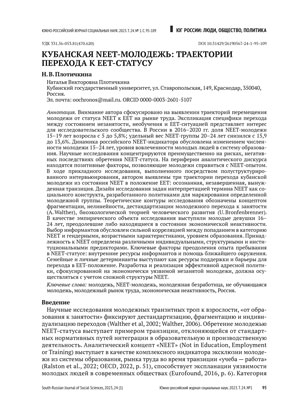Abstract
The author’s focus is on the identification of the trajectories of young people moving from NEET to EET status in the labor market. Of interest to the research community is an explanation of the specificity within the transition between being unemployed, not learning and EET. In Russia, the share of young people aged 15–19 who are NEETs increased from 5 to 5.8 per cent between 2016 and 2020, while the share of those aged 20–24 decreased from 15.9 to 13.6 per cent. The dynamics of the Russian NEET indicator is driven by changes in the number of young people aged 15–24 and their level of participating in the education system. Academic research tends to focus on the risks, i. e. the negative consequences of becoming NEET. The positive factors that enable young people to cope with becoming NEET are marginalized in the analytical discourse. Through applied research using semi-structured interviews, the author identified three pathways of Kuban young people’s transition from NEET to EET status: an intentional, an unfinished and a coerced transition. The research design is based on the interpretation of the term NEET as a social construct, which was developed by policy makers as a label for a particular group of young people. Theoretical research contours are shaped by the concepts of fragmentation, non-linearity and de-standardisation of youth transitions to work (A. Walther) and by the bio-ecological theory of human development (U. Bronfenbrenner). The empirical research focused on young women aged 16–24 who were either overcoming or had overcome economic inactivity. Informants were selected based on their strong correlation with NEET, as well as their gender, age and educational background. NEETs are defined by a variety of individual, structural and institutional predictors. The informants’ internal resources and the support of their immediate environment are key factors in overcoming the experience of being NEET. Family and individual determinants act both as supporting resources and as barriers to entry into EET. The complex structure of NEET should be taken into account when designing and implementing effective targeted policy with a focus on economically vulnerable unemployed youth.
Keywords
References
Буланова, М.Б., Артамонова, Е.А. (2020). NEET-молодежь: европейский контекст и российские реалии. Вестник РУДН. Серия: Социология, 20(1), 64–72. DOI: 10.22363/2313-2272-2020-20-1-64-72
Зудина, А.А. (2019). «Не работают и не учатся»: молодежь NEET на рынке труда в России. Мир России, 28(1), 140–160. DOI: 10.17323/1811-038X‑2019-28-1-140-160
Зудина, А.А. (2018). Дороги, ведущие молодежь в NEET: случай России. Экономический журнал ВШЭ, 22(1), 197–227. DOI: 10.17323/1813-8691-2018-22-2-197-227
Итоги выборочного обследования рабочей силы. М.: Федеральная служба государственной статистики, 2017–2022. Официальный сайт Федеральной службы государственной статистики. Режим доступа https://rosstat.gov.ru/compendium/document/13265
Ломтева, Е.В., Бедарева, Л.Ю. (2022). Поколение NEET: образовательные траектории и поведение молодежи на рынке труда. Материалы экспертного семинара ЦЭНО ИПЭИ РАНХиГС. Режим доступа https://ipei.ranepa.ru/ru/sobytiya-ceno/5358‑pokolenie-neet-obrazovatelnye-traektorii-i-povedenie-molodezhi-na-rynke-truda-i-vne-ego
Assmann, M.L., Broschinski, S. (2021). Mapping Young NEETs across Europe: Exploring the Institutional Configurations Promoting Youth Disengagement from Education and Employment. JAYS, 4, 95–117. DOI: 10.1007/s43151-021-00040‑w
Bronfenbrenner, U. (2001). The Bioecological Theory of Human Development. In U. Bronfenbrenner (Ed.), Making human beings human: Bioecological perspectives on human development (pp. 3–15). Thousand Oaks, CA: Sage Publications Ltd.
Caroleo, F.E., Rocca, A., Neagu, G., & Keranova, D. (2022). NEETs and the Process of Transition from School to the Labor Market: A Comparative Analysis of Italy, Romania, and Bulgaria. Youth & Society, 54(2S), 109S‑129S. DOI: 10.1177/ 0044118X211056360
Eurofound (2016). Exploring the Diversity of NEETs. Luxembourg: Publications Office of the European Union. Retrieved from https://www.eurofound.europa.eu/publications/report/2016/exploring-the-diversity-of-neets
Eurostat (2022). Statistics on Young People neither in Employment nor in Education or Training. Retrieved from https://ec.europa.eu/eurostat/statistics-explained/index.php?title=Statistics_on_young_ people_ neither_ in_ employment_nor_in_education_or_training
Felaco, C, Parola, A. (2022). Subjective Well-Being and Future Orientation of NEETs: Evidence from the Italian Sample of the European Social Survey. Social Sciences, 11(10), 482. DOI: 10.3390/soc sci11100482
Geraldine A., Crosby A. (2023). To be or not to be NEET? The complexity of school-to-work transitions in Brussels. Brussels Studies [Online], 175. Retrieved from http://journals.openedition.org/brussels/6404. DOI: 10.4000/brussels.6404
Kleif, H.B. (2023). A Typology of Transition Patterns Involving Long-Term NEET Episodes: Accumulation of Risk and Adversity. Youth, 3(1), 170–183. DOI: 10.3390/youth3010012
Lorinc, M., Ryan, L., D’Angelo, A., Kaye, N. (2020). De-individualising the ‘NEET problem’: An Ecological Systems Analysis. European Educational Research Journal, 19(5), 412–427. DOI: 10.1177/ 1474904119880402
Nardi, B., Lucarelli, C., Talamonti, M., Arimatea, E., Fiori, V. & Moltedo-Perfetti, A. (2015). NEETs versus EETs: an observational study in Italy on the framework of the HEALTH25 European project. Research in Post-Compulsory Education, 20(4), 377–399. DOI: 10.1080/13596748.2015.1081749
OECD (2022). Education at a Glance 2022: OECD Indicators. Paris: OECD Publishing. DOI: 10.1787/3197152b-en
Parola, A., Donsi, L. (2019). Time perspective and employment status: NEET categories as negative predictor of future. Mediterranean Journal of Clinical Psychology, 7(3), 1–20. DOI: 10.6092/ 2282-1619/2019.7.2093
Pesquera Alonso, C., Iniesta Martinez, A., Munoz Sanchez, P. (2022a). Barriers That Keep Vulnerable People as NEETs. Social Sciences, 11(6), 253. DOI: 10.3390/socsci11060253
Pesquera Alonso, C., Munoz Sanchez, P., Iniesta Martinez, A. (2022b). Is there a uniform NEET identity in the European Union? International Journal of Adolescence and Youth, 27(1), 207–220. DOI: 10.1080/02673843.2022.2065922
Ralston, K., Everington, D., Feng, Z., & Dibben, C. (2022). Economic Inactivity, Not in Employment, Education or Training (NEET) and Scarring: The Importance of NEET as a Marker of Long-Term Disadvantage. Work, Employment and Society, 36(1), 59–79. DOI: 10.1177/0950017020973882
Walther, A. (2006). Regimes of youth transitions: Choice, flexibility and security in young people’s experiences across different European contexts. YOUNG, 14(2), 119–139. DOI: 10.1177/ 1103308806062737
Walther, A., Moerch-Hejl, G., Bechmann Jensen, T. (2002). Youth Transitions, Youth Policy and Participation — State of the Art Report. YOYO Project Working Paper 1. Retrieved from https://www.iris-egris.de/yoyo/pdf/YoyoWP1StateofArt.pdf


